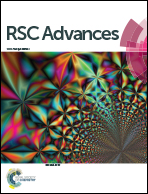Facile preparation of a highly sensitive nonenzymatic glucose sensor based on multi-walled carbon nanotubes decorated with electrodeposited metals†
Abstract
Novel multi-walled carbon nanotubes decorated with nickel, copper, and silver (Ni/CuAg/MWCNT) have been successfully fabricated for a nonenzymatic glucose sensor by the electrocodeposition of copper and silver and sequential electrodeposition of nickel using a MWCNT-modified electrode. The Ni, Cu, and Ag species deposited on MWCNT were indicated by X-ray diffraction (XRD) and scanning electron microscopy (SEM). Tests with various scan rates and pH conditions indicate that a diffusion-controlled in the electrochemical system and the hybrid composite is stable. In alkaline condition, the electrode shows good activity towards glucose oxidation with low overpotential with obvious oxidation peaks at +0.38 V and +0.5 V and a current response that is 1.7–5.8 times greater than those obtained using Ni/CuAg and MWCNT modified electrodes. Amperometry (Eapp. = +0.6 V) indicates a response time of 10 s; one linear range of 5 × 10−6–4.05 × 10−4 M, with high sensitivity of 5007 μA mM−1 cm−2 and a low detection limit of 5 × 10−6 M (S/N = 3). It can effectively analyse glucose concentration avoiding interference. The modified electrode can be a nonenzymatic glucose sensor due to its low overpotential, high sensitivity, good selectivity, good stability, and low cost.


 Please wait while we load your content...
Please wait while we load your content...